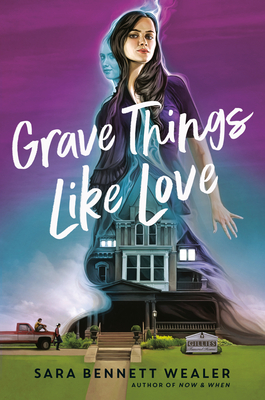
Guest Post: Joy in the Face of Sadness: Helping Normalize Mental Illness in YA by Sara Bennett Wealer
Mental Health is super important to Team BookCrushin and we are always working to help destigmatize the conversation and especially by reading and promoting good representation in YA. We are thrilled to host a guest post from author Sara Bennett Wealer with her new release Grave Things Like Love.

Grave Things Like Love
by Sara Bennett WealerPublished by: Delacorte Press
on October 11, 2022
Genres: Contemporary Romance, Paranormal, Young Adult
Bookshop
Goodreads
A contemporary YA romance with a paranormal twist: what happens when in between trying to decide which boy is the right boy, a girl finds out the funeral home her family owns might be haunted?
Elaine's home is a bit . . . different. It's a funeral home that has been in her family since the 1800s--and it's why everyone calls her Funeral Girl. And even though she's lived there her whole life, there are still secrets to be found.
When Xander, a cute new boy with a penchant for ghost hunting, arrives in town, Elaine feels an instant spark. His daring and spontaneous ways help her go from Funeral Girl to Fun Girl. Then there's Miles, Elaine's oldest friend, who she's starting to see in a completely new light.
After Xander convinces her to stage a seance one night, Elaine discovers that her home might be haunted by a kindred spirit--the daughter of the funeral home's original owner. But who wants to be haunted by the dead when there are boys to spend time with? After all, you only live once. . . .
Guest Post: Sara Bennett Wealer
Joy in the Face of Sadness: Helping Normalize Mental Illness in YA
My YA novel, GRAVE THINGS LIKE LOVE, opens with a girl driving a horse-drawn Victorian
hearse in a small-town parade. Elaine’s as thrilled as any 16-year-old would be with advertising her family’s funeral home so publicly, especially since the job entails wearing a Victorian undertaker’s costume, complete with corset, bustle and top hat.
Writing the scene where Elaine sits atop the hearse, waiting for the parade to start, trying to avoid being seen by her friends, I had her using a relaxation app on her phone—a way to deal with the anxiety I knew she’d be feeling. I wrote that bit without thinking too much about it because it felt so natural that a character like Elaine would have anxiety.
It felt natural because I experience anxiety in much the same way. Anxiety and depression have been in my family for generations; I’ve dealt with them most of my adult life. I didn’t think much about Elaine’s anxiety until my editors said they liked seeing a character for whom mental health wasn’t the focus of their character arc, someone who successfully manages it as a normal part of everyday life.
With that feedback, I leaned in more to showing how Elaine handles her anxiety. And I came to realize how important it is to portray mental health challenges as normal things with strategies not just for coping but thriving. Because it seems like only the last few years that stigmas around mental illness have started to fall away.
My own teens struggle with their mental health. So do many of their friends. It’s easy to blame the pandemic. Or the politically messed up atmosphere they’re growing up in paired with a climate crisis that literally threatens their futures. Or the 24/7 access to social media on their phones.
All that has an impact, I’m sure. But are today’s young people really in a worse place, or do they have adults in their lives who can recognize mental health issues and are more willing—if not proactive—about discussing it and offering solutions?
As I look back at my family tree, I see so many who clearly were struggling, but since society didn’t have the vocabulary, resources or open-mindedness to address things like anxiety and depression, their mental illness went undiagnosed and ended up manifesting in things like broken relationships, substance abuse, even self-harm.
I feel fortunate to be living in a time when treatment is available and increasingly OK to talk about. I’m especially lucky that strategies like mindfulness and exercise work well for me. I’m able to sense when anxiety is growing stronger than my strategies to fight it, and then I’ll take medication. I also go to therapy when life challenges get especially triggering.
That’s pretty much how Elaine in GRAVE THINGS LIKE LOVE does it. And while I’m glad to show someone whose mental illness isn’t a central struggle—while I hope it helps normalize anxiety and shows readers it’s possible to manage successfully, I also want to make clear that not everyone finds it so simple, and that’s OK, too.
I know people who have had a hard time finding treatments that work. Our brain chemistries are all unique. Elaine and I may not experience massive disruptions in our lives due to anxiety, but I don’t want to give the impression that everyone should be able to take a pill and do some deep breathing and be fine.
I do hope mental health continues to be part of our conversations, and that seeking help becomes even easier. My teens and their friends feel comfortable talking about their mental health, but I know many are in environments that look more like the old days. How many of my loved ones would have had different, perhaps better lives if they’d felt comfortable talking about their struggles and received the help I can so clearly see now that they needed?
In GRAVE THINGS LIKE LOVE, Elaine’s funeral director dad talks about the Juxtaposition of the Universe, which to him is joy in the face of sadness. GRAVE THINGS is far from the first young adult novel to feature a character with anxiety, and if a reader doesn’t see themselves in Elaine, then I hope they’ll find other books that speak more to their experience. Anxiety, depression and other mental illnesses can be challenging to live with, but live we must. Because what is the alternative? However we find joy in the face of sadness, we owe it to ourselves and our loved ones to talk about our struggles, to seek and offer help, and to continue making mental health a normal part of everyday life.
Sara Bennett Wealer grew up in Manhattan, Kansas, where she sang in all the choirs and wrote for the high school newspaper. She majored in voice performance at the University of Kansas before deciding she had no business trying to make a career as an opera singer and transferred to journalism school. She went on to become a reporter covering everything from house fires to Hollywood premieres. These days, she writes event scripts and marketing copy while the sun is out. By night, she writes books for young adults. Sara lives in Cincinnati with her husband, two daughters, two dogs and four cats, and she still sings sometimes when her schedule allows. Find out more about Sara on her website.







